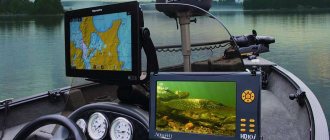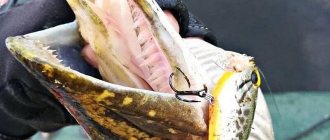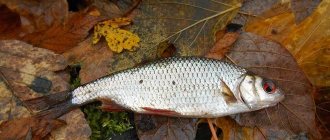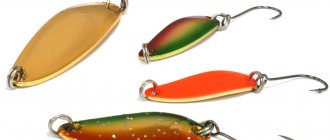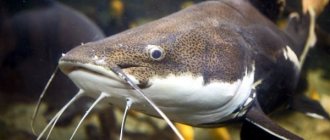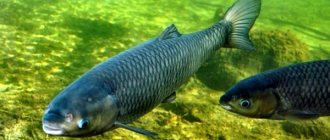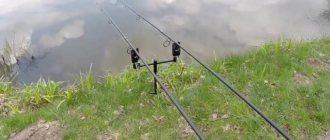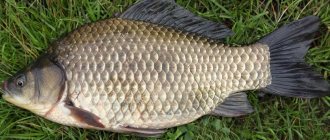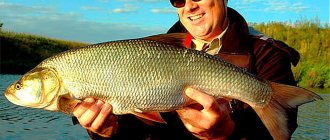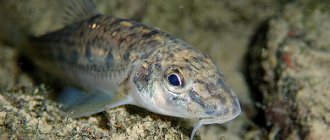Israeli seas and reservoirs are rich in these crustaceans. However, not everyone knows where to find this bait and how to properly place it on a hook.
In this article you will learn not only about methods of catching crabs, but also the secrets of hooking and a lot of interesting and useful information about these ancient inhabitants of flora and fauna.
Content
- 1. General information 1.1. Habitats
- 2. How to catch crabs
- 3. Methods for hooking crabs
- 4. What kind of fish can be caught with bait in the Mediterranean Sea
- 5. Ways to use crab as bait for fishing
- 6. How to preserve crab for fishing
- 7. Useful tips for using crab as bait for sea fishing
- 8. Where to get or buy crabs for fishing in the Mediterranean Sea in Israel.
- 9. Interesting facts about crabs
- 10. Useful links
General information
Crabs or short-tailed crayfish have been known since the Jurassic period. Representatives of antiquity have a small head, a short belly and a wide carapace. Two large claws are used for walking. The difference between females and males is the presence of the first 4 abdominal limbs, while male invertebrates have only 2 of them. They move quickly and sideways.
1.1 Habitats
Seashore, freshwater near the coastline and land. Crabs hide among reefs, shells and rocks.
1.2 What do crabs eat?
The diet consists of invertebrates and detritus.
1.3 When can you catch a crab?
Morning or evening hours are the most effective for catching this bait, since crabs are most active at this time of day.
Where and how to catch crab.
In theory, crab fishing in the sea can be carried out throughout its entire territory, but due to the difficulty of hunting for deep-sea crustacean species, it is better for an amateur crab fisherman to prefer shallow water or a relatively shallow depth, no higher than 20 meters. When choosing a promising place for crab hunting, it is recommended to give preference to deserted and quiet rocky shores.
A clear sign of a place suitable for catching arthropods is the presence of small crabs on the shore, emerging from the water to warm themselves in the sun. Sensing danger, these kids quickly retreat under the stones. If there are small individuals on the shore, this is a clear sign of the presence of large crabs at depth. For shelter, large and medium-sized individuals usually use stones, large shells, burrows and flooded construction or man-made debris.
If there is information about a sunken ship on the bottom near the coastlines, we recommend visiting this area for the purpose of catching crab. Surely this outing will bring an abundant catch of trophy crab. Having diving experience and the necessary equipment for diving, the hunt will become much more successful. You can descend to depth only with working diving suits and cylinders in the company of a partner who insures the miner in case of emergency situations, thus guaranteeing your safety. In the Black Sea, crab is caught throughout the year.
In the Far East, the most successful crab fishing in the sea begins in October.
Sometimes stable catches are obtained only in early January. During this period of the year, the water temperature in the Bering and Okhotsk Seas, where the trophy red king crab lives, drops to 4 degrees, accompanied by moderate winds, which makes catching a very difficult and dangerous matter.
Commercial crab fishing begins in mid-October and lasts until the very beginning of May. From May to September, the arthropod migration season begins, when crab offspring hatch from eggs. Later, male and female crabs migrate together to the molting sites, where new eggs are fertilized - after which they are incubated until the next migration season. Any harvesting of crab during the spawning period is strictly prohibited.
In addition to the spawning period in different regions, the duration of restrictions on production can be set individually, by a joint decision of local authorities and scientists. Often, in Primorye, fishing is prohibited from May until the end of August, and in some individual areas - until the second half of September. Off the coast of Kamchatka, the catch in some cases ends already before the beginning of February. And in some areas of the coast, fishing may be completely prohibited for some time even during the usual fishing season.
How to catch crabs
Ways to catch crabs:
- pricking on a kebab skewer;
- landing net;
- hands (if there is a good reaction);
- using a rope (twine), tie the bait to the end of it and wait for the crab to grab it;
- fishing for crab in water at a depth of up to 1 m under rocks and in other reef areas;
- a spinning rod (they catch some types of crabs, for example, blue crabs in Israel) or a 3 m telescopic rod, with a float, a weight and a hook.
- For catching crabs, a grill from an old fan is also suitable, on the center of which the bait is placed;
- homemade crab catchers.
Did you know that in the Mediterranean Sea there is an unusually beautiful crab called the “blue crab”? For a detailed description of this inhabitant, its character and habitat, food preferences, what set of gear and equipment to use to catch it, read here
You can familiarize yourself with some types of traps (crab catchers) used by fishermen to catch crabs at
A short video on how to use crab traps
An interesting video on how to make a crab catcher yourself at home from a plastic bottle
The danger of the crab lies in its claws, which can cause significant damage. In order to grab it correctly, you need to move it in front of the prey with one hand, thereby distracting it, and with the other, press it firmly by the shell to the ground (or the seabed). Then, with your free hand, grab both claws to immobilize them.
Types of crab baits:
- turkey leg;
- spoiled pieces of fish;
- pieces of fresh fish;
- chicken necks;
- shellfish (snail, cuttlefish);
- fresh meat (for example, beef or chicken).
You can find out about other unique ways of catching this bait at https://fastcarp.ru/ostalnoe/gde-i-kak-pravilno-lovit-krabov-na-more.html
Methods of catching crabs.
There are many effective ways to catch crabs; there are passive methods using crab traps and trots, as well as active ones, which include hand fishing. The manual method of harvesting crab is ideal for vacationers on the seashore. If you approach the matter of hunting correctly and rationally, then with your bare hands you can catch enough crabs for a good dinner with your family. There are relatively accessible, simple and standard methods of hunting crab, which we will consider in the continuation of the article in more detail.
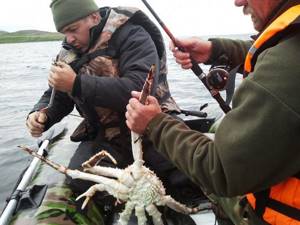
Crab fishing with a fishing rod is popular, where it is important to choose an effective and attractive bait. For the rock crab species, live animal baits are used. This crab reacts poorly to rotten meat. But the royal variety of arthropod bites exclusively on rotten meat. The rod is equipped with a braided fishing line with a medium-sized hook on which the selected bait is placed, feeding it into the promising fishing zone.
Catching a crab with your hands is successful, but the idea has a certain danger, namely the risk of the hunter being attacked by the claws of an arthropod. The main condition for effective crab hunting is determining the habitat of the prey. You can experiment in your search, preferring rocky areas, or find out crab aggregation points from experienced local fishermen and crab catchers. After reconnaissance of the prey's location, all that remains is to deftly grab it. Thick gloves on your hands help to avoid injury from the powerful claws of the trophy. It is best to hunt in the calm, rolling aside small boulders in the surf zone.
Catching crab with gear involves the use of a special device - a crab catcher. There are open and closed types of crab traps. The open design is quite primitive - it is a round metal rim to which the net and bait are attached. Open varieties sink to the bottom for 30-40 minutes, then they are sharply raised from the bottom to the surface along with the crabs gathered on the canvas.
A closed crab trap is designed in such a way that once the prey enters the metal mesh, it is no longer able to escape from the fishing cage. Closed structures are installed at promising fishing points throughout the night. Crawling inside, the crab remains until the control check of the device in the morning.
Crab fishing is considered an industrial method of production. Installing a system for catching crabs involves connecting nets to each other and installing them in places where arthropods feed. Typically, a crab catcher fishes a dozen promising points simultaneously.
Catching crabs from a small boat is a common method for catching most species of marine arthropods. The trot is delivered and installed from the boat, which is installed at a relatively shallow depth. Next, taking two floating buoys, they are connected to each other with a fishing line one meter long. The first buoy is fixed with an anchor. The second one is released freely into the water. Leashes with hooks and bait are attached to the fishing line. Prey caught on hooks is collected in the early morning and late evening, when the crabs are especially active in their feeding activity.
Shore fishing is similar to hand fishing strategies. You can’t count on catching large individuals, but you can collect small and medium-sized rock crabs right on the shoreline. It is enough to walk along the shore and lift boulders that are heavy enough for a hunter. Discovered as a result of the loss of its shelter, the crab begins to actively bury itself in the sand or suddenly rushes towards the water. The hunter should take a position from the sea, simply picking up the marked trophy and putting it in a portable net prepared for this purpose.
Methods for hooking crabs
When equipping the rod with a sinker, a meter-long leader (diameter up to 0.4 mm) and two hooks of size No. 1-2, use the shell of a small crab (without claws), which is hooked to these hooks at the back.
Severed crustacean claws can be used as a wobbler by attaching them to a tee.
You need to tear off the legs of the crab by twisting it and hooking the hook in the twisted place onto the meat, so the bait will sit securely on the hook.
Large fish are caught using pieces of crab meat. The hook must be passed through the holes left after removing the legs.
Crabs that are not large in size are mounted whole.
A crab without a shell is considered a good bait. In Israel, such a crab is called “soft”. It can be easily found among algae and stones.
Catching crabs using trot
Trot fishing can take time, but the catch is always good. You will need skill and the necessary tools.
You will need:
- net
- buoys 2-5 pcs;
- bait;
- thick gloves;
- boat;
- hooks;
- anchor;
- rope;
- fishing line
- ice box.
First of all, you will need a boat; installing a rope from the shore will not work. They are installed at a shallow depth, you need to take two buoys and connect them with a fishing line, its length is 1 m. Then, another line with an anchor is attached to one of the buoys. Hooks with bait are attached to the fishing line.
Crabs are active in the morning or late evening and should be collected during this period. Take a net and carefully remove them from the bait, using gloves. Install several trots using different types of attachments.
After the crabs are caught, they are placed in a box of ice, which must be taken to the boat. In this state, crustaceans live for 24 hours, then die. Therefore, you should prepare them in time to avoid poisoning.
What kind of fish can you catch with bait in the Mediterranean Sea?
The meat of this crustacean is successfully pecked by:
- mullet;
- flounder;
- croaker;
- garfish;
- mullet;
- laurel;
- farida;
- locus;
- barracuda;
- intias;
- sea burbot;
- gumbar;
- scorpionfish;
- goby.
Small crab is used when catching gobies.
Types of gear used: float or bottom rod.
How to Preserve Crab for Fishing
- to preserve the crab meat and its density, so that it stays more securely on the hook, it is salted in a jar;
- raw crustacean meat should be stored in the refrigerator or other cool place for no more than 4 days;
- live individuals are stored in a shady place in a container (box) with wet algae;
- For short-term storage, a bucket with sea water and a small amount of algae is suitable, place the bait in it and cover it with a towel (rag) soaked in sea water. The bucket should be in a cool place;
- For long-term storage, the bait is frozen.
Best weather for crab
Oddly enough, but crab is perfectly caught in sunny weather. Rain, snow and other precipitation negatively affect its activity, as well as a sharp change in the atmospheric front. Crab fishing takes place throughout the entire freeze-up period, however, like any other fishing, it is not always successful. Crab yields depend on climatic conditions, season changes and fishing zones. It happens that an underwater inhabitant is perfectly caught at one point, but after several days it seems to move to another zone. Migrations of crabs, especially their large representatives, are associated with the abundance of food supply, changes in water temperature, etc.
Useful tips for using crab as bait for sea fishing
- do not use boiled crab as bait, as its meat does not stick well to the hook and is quickly taken away by small fish;
- when catching bait, it is imperative to use protective gloves to prevent injury from the tentacles;
- use only sharp hooks with a long shank (for small crabs), and large specimens are placed on hooks with a short shank with the hook bent to the side;
- if the shell is dense, the bait is cleaned, and if it is soft, it is placed on a hook with a shell;
- in the absence of the opportunity to purchase or catch it yourself, you can use canned crabs, which have a rich aroma, but such bait is not durable;
- when storing crabs while fishing in a bucket, you should beware of seagulls, as these birds hunt them;
- The shelf life of fresh crab is no more than 24 hours.
Crab on a fishing rod
In Primorye, crabs have become so prolific that they rush to flounder fishing rods
But sea “spiders” have to be thrown back into their native element, and the delicacy has to be bought at an exorbitant price
With the opening of spring navigation for small vessels in Primorye, amateur fishermen feel like characters in Krylov’s fable. Remember: “The eye sees, but the tooth is numb”? Only the fox licked the grapes, which it could not reach, and our fishermen, with tears in their eyes, “deported” the crabs back to the sea, which almost climbed into the boats themselves.
“I don’t understand why I should throw away a crab that accidentally caught a fishing rod, and then, in order to pamper my family, go to the store and buy claws for 750-950 rubles per kilogram,” Vladivostok fishing enthusiast Vyacheslav Zimin is outraged by the situation. -If you dive into the crab trails, along the bottom they crawl over each other in three layers, multiplying like never before. Moreover, when there is a lot of crab, it eats up everything that moves at the bottom, and the result is a desert.
In fact, the ban on the production of the seafood delicacy, which has been in effect in Primorye since 2002, when the crab population in the water area was under threat of destruction, has played a positive role. But the subsequent population explosion in the depths of the sea did not change anything in the situation where crab remains a delicacy inaccessible to residents of coastal areas due to its high cost.
Of course, our fishermen are not such innocent violets. The technology for deceiving the fisheries inspection has been worked out. By the way, while boasting about their catches on fishing forums, our people came up with a special nickname for the crab. If you read that someone caught a couple of “spiders”, we are not talking about insects at all.
“I go out on a boat to fish for flounder, and the bait - squid or mussels - is attacked by a crab. It clings to an ordinary donka,” Zimin shares his experience. — During one fishing trip you catch three to five pieces. Many people let them go because they are afraid of running into a fine. But many people pack the caught crabs in a net and lower them overboard on a string. If a suspicious boat appears, cut the string with a knife, and no one will prove anything.
True, such a “drowned person” in a net is still doomed to perish at sea, so it ends up neither for himself nor for the people. Although in fact, forbidding an amateur with his fishing rods to catch anything at all is ridiculous. The species cannot be destroyed with a fishing rod.
Crabs in Primorye will die a natural death - from old age
Research by scientists confirms the observations of amateurs - there are a lot of crabs. To compile the forecast, TINRO-Center sent its ships on scientific voyages. The crabs were counted by the teams of the R/V "Bukhoro" and "Ostratelny". Trawls and traps placed in the interests of science showed that commercial male king crabs formed the densest aggregations in the northern and central regions of Northern Primorye and the eastern part of Peter the Great Bay. So there will be no harm if this year they catch 0.58 thousand tons of the sea delicacy, which is also called king crab for its excellent taste.
“In the last five years, in the southern part of the Primorye subzone, there has been a steady trend of increasing the number of commercial male king crabs, which indicates an actively ongoing process of restoring its fishing potential,” says Valery Koblikov, head of the laboratory of commercial crustaceans.
And snow crabs breed and reproduce even more actively. So much so that, according to scientists, in 2013, without any damage to the biosphere, 34.86 thousand tons of opilio could be fished out of sea waters. At the same time, amateur fishing accounted for only 10 tons in Primorye. So most of these marine inhabitants will simply die a natural death - from old age, because no one has lifted the restrictions on their fishing.
The ban could be lifted in mid-summer
Officials nevertheless heeded the recommendations of scientists. But the necessary paperwork to give fishermen more freedom will continue to wander through bureaucratic corridors for a long time.
— With the growth of commercial stocks in the Primorye subzone, it is planned to lift the ban on fishing for Kamchatka crab, blue crab, and hairy crab. New Fishing Rules for the Far Eastern Fishery Basin, which include the above changes, will be approved by the Ministry of Agriculture of the Russian Federation in June-July of this year (the crab goes to depth at this time and will be practically inaccessible from a boat - ed.) - Sergei Nastavshev, acting director of the Department of Fisheries of the Primorsky Territory, told Komsomolskaya Pravda.
And according to the current rules, within the borders of our region, during recreational and sport fishing, the production of Kamchatka crab, blue crab, spiny crab, hairy crab, and opilio snow crab is prohibited.
However, there is an exception to this prohibition: you can apply for a permit for extraction from organizations that have been allocated quotas for the extraction of these valuable biological resources.
True, the seafood delicacy can be legally obtained only south of Cape Zolotoy in the Terneysky region. In 2013, only four coastal enterprises that received quotas for catching arthropods living in the depths have the right to organize recreational crab fishing.
“We issue personalized vouchers to amateurs,” explained Anatoly Dub, director of Ulov LLC. – We provide instructions on the marine areas permitted for fishing and legal methods of production. The cost of the tour differs depending on the type of crab. For example, a “license” to catch two Kamchatka specimens will cost 500 rubles.
For residents of the northern regions, this may make sense. But it’s unlikely that fans from Vladivostok will travel 600 kilometers for a couple of copies.
SPECIFICALLY!
How much was allocated for recreational fishing in 2013?
Kamchatka crab
- "Primorrybvod" - 3,311 tons
- Preobrazhensky Fish Factory - 3,311 tons
- Society of Hunters and Fishermen "Tetyuhe" - 0.133 tons
- LLC "Ulov" - 13.245 tons.
Snow crab – opilio
- "Preobrazhensky Fish Processing Plant" - 0.909 tons
- Ulov LLC - 9,091 tons
Hairy crab
- Only “Preobrazhensky Fish Processing Plant” - 3 tons
HELP "KP"
The Kamchatka crab is one of the largest species, for which it is nicknamed the king crab. The weight of large males can reach 7.5 kilograms. However, even a 4-kilogram prey is not bad. They live at depths from two to 270 meters.
Opilio (snow crab) is found mostly at depths of seven to 100 meters. In the spring it approaches the shores to procreate. Weight is 2-2.5 kg, rarely up to 4 kilograms. It differs from other types of Far Eastern crabs in its smooth shell and relatively thin walking legs.
The hairy quadrangular crab (there is also a pentagonal crab, but it is very small) usually lives on sand and pebble soils in the range from 10 to 100 meters. In the waters of Rudnaya Bay and its environs, it begins to be found in winter (from January) at depths of 2-3 meters. Then, with an increase in water temperature, it moves deeper and already in June it is found at a depth of about 20 meters. 700 grams is the maximum weight. This species is highly respected by the Japanese and is considered healing.
Important!
Violation of the rules for the extraction (catch) of aquatic biological resources and other rules regulating the implementation of industrial fishing, coastal fishing and other types of fishing entails the imposition of an administrative fine
- for citizens in the amount of one thousand to two thousand rubles with or without confiscation of the vessel and other equipment for the extraction (catch) of aquatic biological resources;
- for officials - from ten thousand to fifteen thousand rubles with or without confiscation of the vessel and other equipment for the extraction (catch) of aquatic biological resources;
- for legal entities - from one hundred thousand to two hundred thousand rubles with or without confiscation of the vessel and other equipment for the extraction (catch) of aquatic biological resources.
Source: kp.ru
Where to get or buy crabs for fishing in the Mediterranean Sea in Israel
If it is not possible to obtain this type of bait yourself, then you should use the services of online stores.
Before fishing, bait can be purchased at Israeli seaports (buy from fishermen, for example, the port in Yafo and Akko)
On one of the most popular Israeli fishing forums you can find a list of all Israeli fishing stores selling bait, https://www.israfish.com/WebFish/Shopping/IsraelShops.htm
Interesting Facts
A unique species of crab called "Scyllarides latus" or "sigal, sigalite", which means purple, is becoming extinct in Mediterranean waters. It is interesting because it does not have a shell, and the meat of this crustacean is very tasty and is a delicacy in Israeli restaurants.
In Israel, there is a type of crab called “blue”.
The difference between a female crab and a male: females have a much wider abdomen than males, because they bear future offspring there.
As it grows, the crab changes its shell to a more durable one. At the right time, the crustacean takes in water and swells, from such pressure the old shell bursts. The crab stays in shelter for several days and builds up new defenses.
The “marbled” type of crab is called a spider because of the presence of hairs on its legs.
Not all crabs are capable of biting; for example, sand crabs are absolutely harmless.
Collecting tackle
There are two main types of devices used to catch crabs: a parachute and a classic metal pin. Each trap is set using a rope and reel. Parachutes have a folding design. Long rods extend from the metal center, along the perimeter of which there is a mesh line. There is a nozzle in the center of the structure, and a crab caught in the trap cannot break away when it is lifted. A parachute is considered a more reliable piece of equipment because it has a minimal percentage of descents. On the other hand, freeing prey from the captivity of metal rods and fishing line is much more difficult and takes a lot of time.
A classic pin has an approximate size of 15 by 8 centimeters. It is used to thread the bait. In the upper part of the body there is a bundle of fishing line, to which the crab clings with its claws. Compared to a parachute, the gear looks more compact, but there are many more exits from it. At the same time, it is faster to unhook small prey and release it into its native element without causing harm.
Read: Winter fishing for chub
The following is used as a nozzle:
- fresh and frozen fish;
- poultry and animal offal;
- fish heads and other remains;
- other meat products.
Most often, the bait is a small herring, weighing up to 300-400 grams. Also used are such types of fish as ugai, navaga and kunja. The bait must be checked every 30-40 minutes, changing the fishing area in case of small crab bites or the presence of a lot of amphipods.
Fishing technique
When placing traps, you must maintain a distance between them. Adjacent gear should be at a distance of 15-20 meters from each other. Thus, it is possible to cover a large part of the water area by defining work zones. Beginners or visiting fishermen are recommended to go out on the ice with more experienced comrades who will show the intricacies of fishing firsthand.
The crab bite is careful, since the sea creature is slow. When moving the cord, the main thing is not to rush. A crab clinging to the bait firmly holds onto the stones with its paws, so sudden movements by the fisherman can leave it without prey. The presence of a crab can be felt by the heaviness at the other end of the trap. Experienced crab fishermen feel with their fingers how the prey is gradually lifted off the bottom. When the crab is in thick water, it is necessary to remove the trap evenly, without unnecessary haste or stops. It is necessary to pull out the inhabitant of the seabed with extreme caution. In order not to lose the prey, it is grabbed by the claw right in the hole, without being lifted into the air.
Read: Winter fishing for pike perch
As a rule, the traps are quite wide and using a regular drill to make a hole for the tackle with the prey is problematic. When biting a crab, local sea lovers use a long saw, with which they can drill a hole in a matter of seconds. They take out an extra piece of ice with a long hook - another indispensable tool for a crabber.
Useful materials about crab
https://forum.israfish.com/viewtopic.php?f=35&t=8646 - Notes from Israeli anglers about crab on one of the most popular fishing forums in Israel;
https://hit-fishing.com.ua/blogs_news/blogs/1028/ — Article about baits for sea fishing;
https://pravda-chto.ru/pro-kraba/ — Article about interesting facts about crabs;
https://podvodnyj-mir-i-vse-ego-tajny.ru/catch-crabs-catch-methods/ - Interesting article about methods of catching crabs;
https://fastcarp.ru/ostalnoe/gde-i-kak-pravilno-lovit-krabov-na-more.html - Detailed description of where to catch crabs and how to do it;
